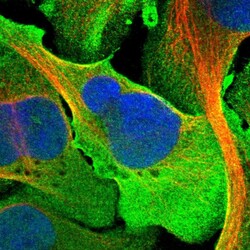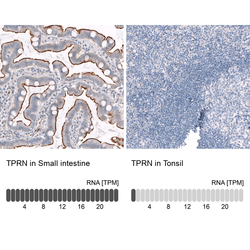Antibody data
- Antibody Data
- Antigen structure
- References [8]
- Comments [0]
- Validations
- Immunocytochemistry [1]
- Immunohistochemistry [1]
Submit
Validation data
Reference
Comment
Report error
- Product number
- HPA020899 - Provider product page

- Provider
- Atlas Antibodies
- Proper citation
- Atlas Antibodies Cat#HPA020899, RRID:AB_1845835
- Product name
- Anti-TPRN
- Antibody type
- Polyclonal
- Description
- Polyclonal Antibody against Human TPRN, Gene description: taperin, Alternative Gene Names: C9orf75, DFNB79, FLJ90254, Validated applications: IHC, ICC, Uniprot ID: Q4KMQ1, Storage: Store at +4°C for short term storage. Long time storage is recommended at -20°C.
- Reactivity
- Human
- Host
- Rabbit
- Conjugate
- Unconjugated
- Isotype
- IgG
- Vial size
- 100 µl
- Concentration
- 0.1 mg/ml
- Storage
- Store at +4°C for short term storage. Long time storage is recommended at -20°C.
- Handling
- The antibody solution should be gently mixed before use.
Submitted references RIPOR2-mediated autophagy dysfunction is critical for aminoglycoside-induced hearing loss
Reducing Taperin Expression Restores Hearing in Grxcr2 Mutant Mice
Collapsin Response Mediator Protein 1 (CRMP1) Is Required for High-Frequency Hearing
N-Terminus of GRXCR2 Interacts With CLIC5 and Is Essential for Auditory Perception
Murine GRXCR1 Has a Different Function Than GRXCR2 in the Morphogenesis of Stereocilia
GRXCR2 Regulates Taperin Localization Critical for Stereocilia Morphology and Hearing
CLIC5 stabilizes membrane‐actin filament linkages at the base of hair cell stereocilia in a molecular complex with radixin, taperin, and myosin VI
Targeted Capture and Next-Generation Sequencing Identifies C9orf75, Encoding Taperin, as the Mutated Gene in Nonsyndromic Deafness DFNB79
Li J, Liu C, Müller U, Zhao B
Developmental Cell 2022;57(18):2204-2220.e6
Developmental Cell 2022;57(18):2204-2220.e6
Reducing Taperin Expression Restores Hearing in Grxcr2 Mutant Mice
Liu C, Luo N, Zhao B
Neuroscience 2022;498
Neuroscience 2022;498
Collapsin Response Mediator Protein 1 (CRMP1) Is Required for High-Frequency Hearing
Li J, Liu C, Zhao B
The American Journal of Pathology 2022;192(5):805-812
The American Journal of Pathology 2022;192(5):805-812
N-Terminus of GRXCR2 Interacts With CLIC5 and Is Essential for Auditory Perception
Li J, Liu C, Zhao B
Frontiers in Cell and Developmental Biology 2021;9
Frontiers in Cell and Developmental Biology 2021;9
Murine GRXCR1 Has a Different Function Than GRXCR2 in the Morphogenesis of Stereocilia
Liu C, Zhao B
Frontiers in Cellular Neuroscience 2021;15
Frontiers in Cellular Neuroscience 2021;15
GRXCR2 Regulates Taperin Localization Critical for Stereocilia Morphology and Hearing
Liu C, Luo N, Tung C, Perrin B, Zhao B
Cell Reports 2018;25(5):1268-1280.e4
Cell Reports 2018;25(5):1268-1280.e4
CLIC5 stabilizes membrane‐actin filament linkages at the base of hair cell stereocilia in a molecular complex with radixin, taperin, and myosin VI
Salles F, Andrade L, Tanda S, Grati M, Plona K, Gagnon L, Johnson K, Kachar B, Berryman M
Cytoskeleton 2013;71(1):61-78
Cytoskeleton 2013;71(1):61-78
Targeted Capture and Next-Generation Sequencing Identifies C9orf75, Encoding Taperin, as the Mutated Gene in Nonsyndromic Deafness DFNB79
Rehman A, Morell R, Belyantseva I, Khan S, Boger E, Shahzad M, Ahmed Z, Riazuddin S, Khan S, Riazuddin S, Friedman T
The American Journal of Human Genetics 2010;86(3):378-388
The American Journal of Human Genetics 2010;86(3):378-388
No comments: Submit comment
Supportive validation
- Submitted by
- Atlas Antibodies (provider)
- Main image

- Experimental details
- Immunofluorescent staining of human cell line U-2 OS shows localization to plasma membrane.
- Sample type
- Human
Supportive validation
- Submitted by
- Atlas Antibodies (provider)
- Enhanced method
- Orthogonal validation
- Main image

- Experimental details
- Immunohistochemistry analysis in human small intestine and tonsil tissues using HPA020899 antibody. Corresponding TPRN RNA-seq data are presented for the same tissues.
- Sample type
- Human
- Protocol
- Protocol
 Explore
Explore Validate
Validate Learn
Learn Immunocytochemistry
Immunocytochemistry